#Suborder: Ensifera
Explore tagged Tumblr posts
Text
3 I'm not confident in, but I'd guess suborder ensifera which lines up with the ID someone else gave!
1 looks like panurginus, but very not sure.
7 looks like anthrenus of some kind.
Gorgeous photos of some beautiful li'l fellers, either way!
Poached-egg Pollinator Paradise

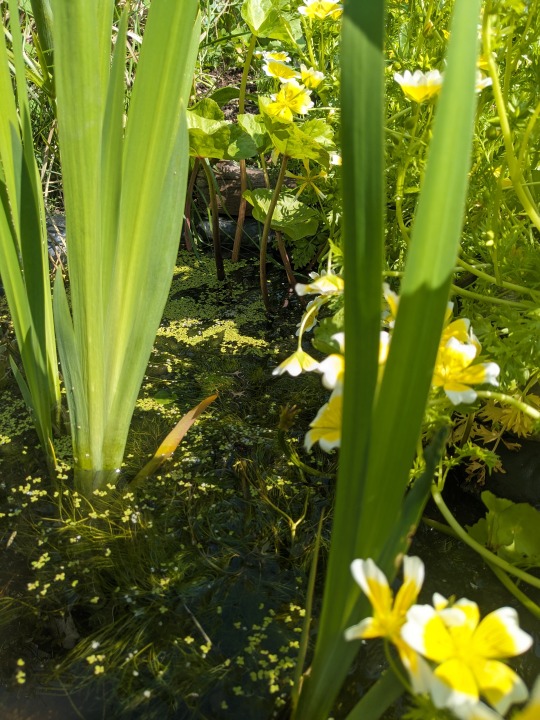
There is a patch of poached-egg flowers growing next to my pond. Pollinating insects love it, and I love to watch them. Here are a few of this weekend's visitors.
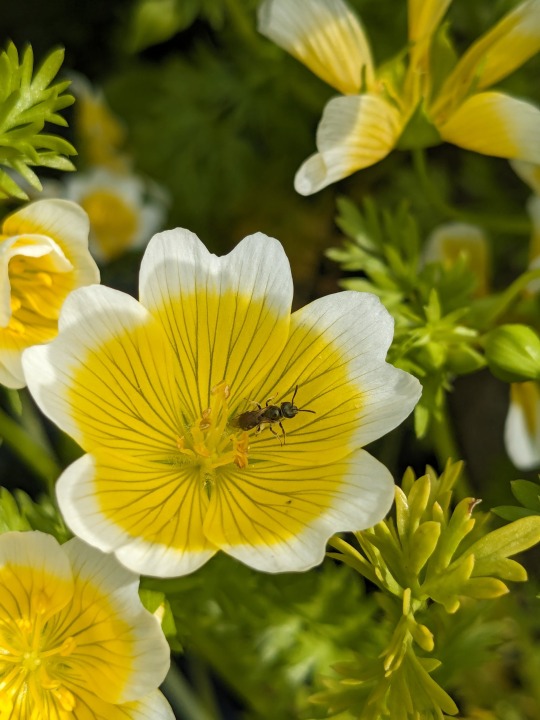
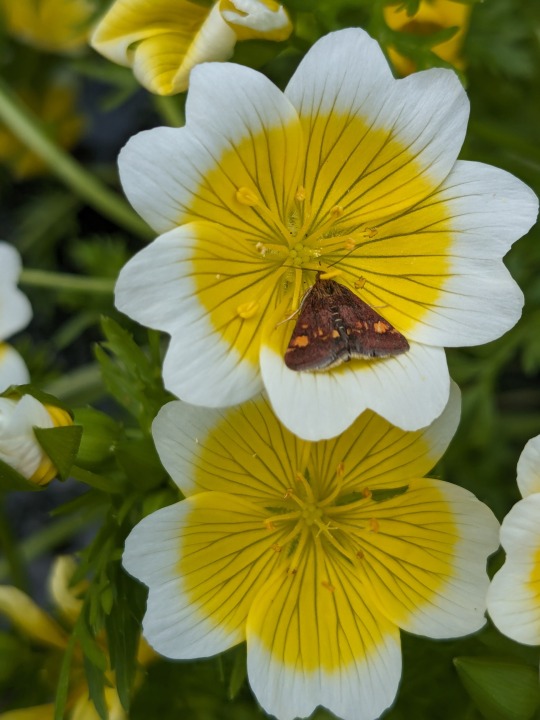
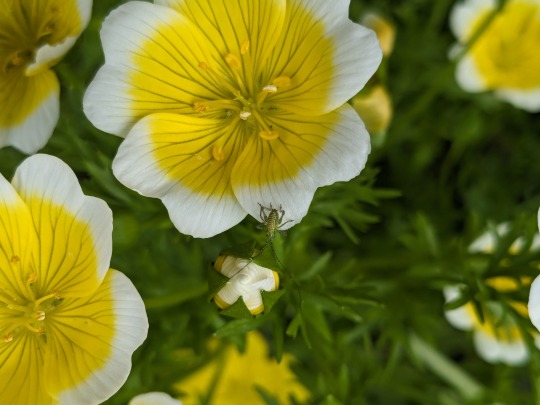
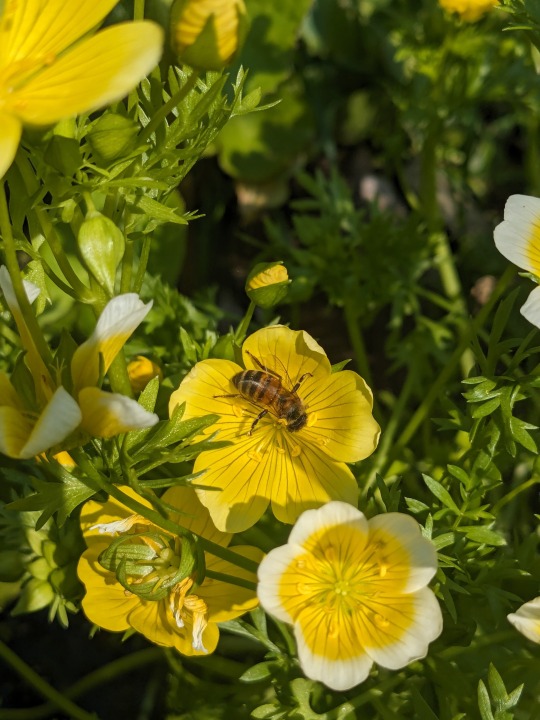
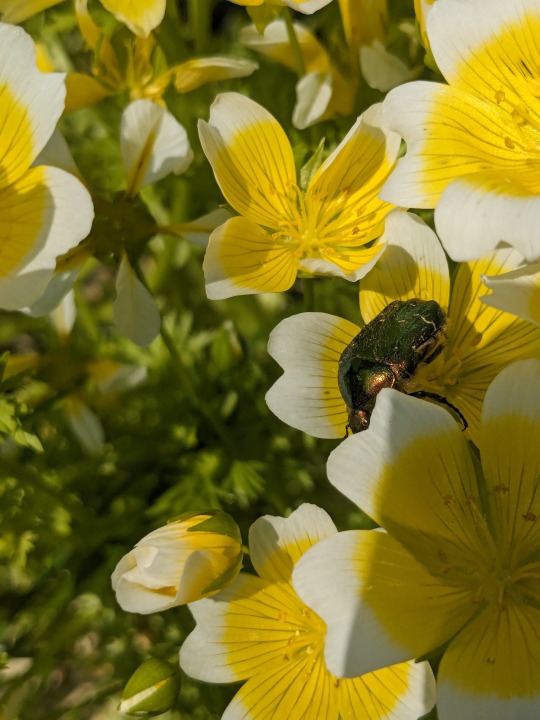
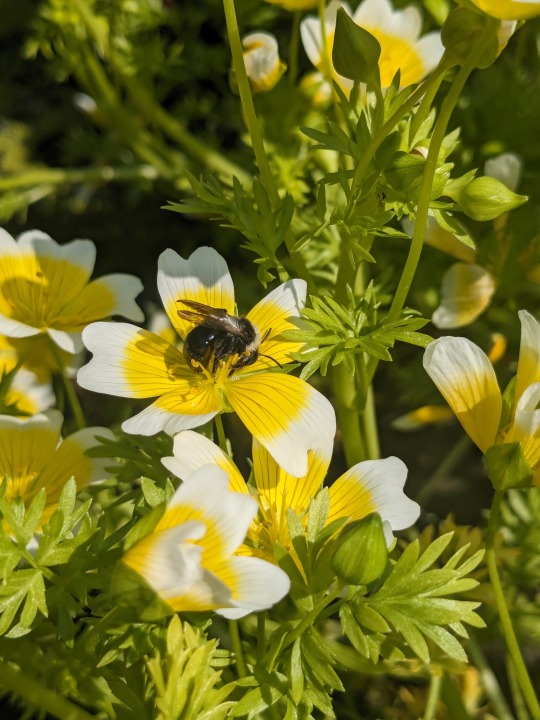
??
Mint moth
??
Honeybee
Rose chafer beetle
Ashy mining bee
If you are familiar with bugs 1 and 3, please let me know their names! And grow this plant if you can!
132 notes
·
View notes
Note
hola katydid!! Me encantó tu relato sobre los saltamontes (katydid), me despertaron muchas dudas sobre estos insectos, siempre he pensado que grillo, chicharra , saltamontes y chapulín son cosas diferentes, originalmente trataba de contarte sobre los chapulines pero no sabía si decirte si eran grillos o saltamontes.
Buscando resulto que el grillo pertenece al suborden Ensifera, tiene antenas largas, sus colores son opacos, su cuerpo es tosco, sus saltos son torpes y sus alas son cortas.
Los saltamontes y chapulines son del suborden Caelifera, sus colores son brillantes, y son ágiles al volar, también su aparto auditivo está en diferentes partes.
Entonces puedo decirte con seguridad que el chapulín es un saltamontes. Chapulín viene del náhuatl del chapōlin, de chapā[nia] ‘rebotar’, y ōlli ‘hule’, ‘insecto de que brinca como pelota de hule’ .
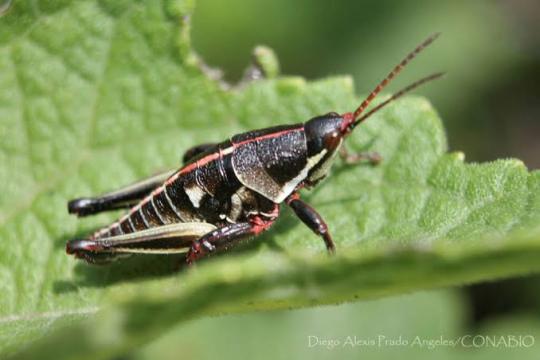
el nombre chapulín se usa genéricamente en México y America Central para las siguientes especies:
Todas las de la familia Acrididae, las langostas.
Todas las del suborden Caelifera (al cual pertenece la familia Acrididae), los saltamontes.
Hay bastantes tipos de chapulines si quieres puedes verlos en la página de la Wikipedia: https://es.m.wikipedia.org/wiki/Chapul%C3%ADn
el Sphenarium purpurascens, y el Sphenarium histrio, son chapulines de milpa

Y estos se comen en Mèxico y no es barata, nosotros la conseguimos con facilidad cada semana en los tianguis a 50 pesos por cucharada que son como 2 o 3 dolares, son muy sabrosos, se venden mucho en Oaxaca, chistosamente hay gente en México que no sabe que siquiera el chapulín es comestible.
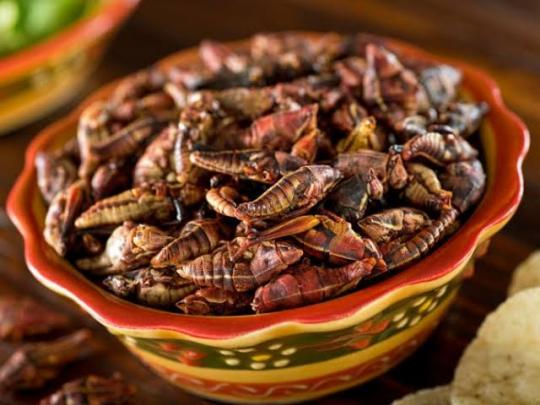
El chapulín es icónico incluso digo lugar a un personaje popular en nuestro país: el chapulín colorado:

Chapultepec proviene del náhuatl “Chapulli” que significa saltamontes y “Tepe” (tl) cerro, “Cerro del Chapulín”,

Aquí está una escultura, es un glifo mexica que representa a Chapultepec.
El chapulín es considerado una plaga, actualmente son criados para su consumo y en Oaxaca son snacks que se le ponen a los tacos.
Perdón por tanta información y espero no ser aburrida pero cuando mencionaste que en Tailandia era un manjar el saltamontes se me vino a la mente el chapulín !! Y quería contarte todo esto, muchas gracias por su atención!!

Oh WHOA, thank you for all the awesome bugs! You must have spent ages on this.
Google translate for English speakers:
Hi katydid!! I loved your story about grasshoppers (katydid), I had many doubts about these insects, I have always thought that crickets, cicadas, grasshoppers and grasshoppers are different things, I originally tried to tell you about grasshoppers but I didn't know whether to tell you if they were crickets or grasshopper.
Searching turned out that the cricket belongs to the Ensifera suborder, it has long antennae, its colors are opaque, its body is coarse, its jumps are clumsy and its wings are short.
The grasshoppers and grasshoppers are of the Caelifera suborder, their colors are bright, and they are agile when flying, also their auditory apparatus is in different parts.
So I can tell you for sure that the grasshopper is a grasshopper. Chapulín comes from the Nahuatl word chapōlin, from chapā[nia] 'to bounce', and ōlli 'rubber', 'insect that jumps like a rubber ball'.
Me: That's a cute grasshopper! The difference between grasshoppers and crickets is confusing to the average person (including me). Katydids have been called long-horned grasshoppers and bush crickets even though they're actually a different family of insect.
The name grasshopper is used generically in Mexico and Central America for the following species:
All of the family Acrididae, the lobsters. All those of the suborder Caelifera (to which the Acrididae family belongs), the grasshoppers. There are many types of grasshoppers if you want you can see them on the Wikipedia page: https://es.m.wikipedia.org/wiki/Chapul%C3%ADn
the Sphenarium purpurascens, and the Sphenarium histrio, are milpa grasshoppers
And these are eaten in Mexico and it is not cheap, we easily get it every week in the tianguis for 50 pesos per tablespoon, which is about 2 or 3 dollars, they are very tasty, they are sold a lot in Oaxaca, funny, there are people in Mexico who he doesn't know that even grasshoppers are edible.
Me: I've tried eating insects before. They mostly just taste like whatever spices you use.
The grasshopper is iconic I even say place to a popular character in our country: the red grasshopper.
Chapultepec comes from the Nahuatl “Chapulli” meaning grasshopper and “Tepe” (tl) hill, “Chapulín Hill”.
Here is a sculpture, it is a Mexica glyph that represents Chapultepec.
The grasshopper is considered a pest, currently they are raised for consumption and in Oaxaca they are snacks that are added to tacos.
Sorry for so much information and I hope I'm not boring but when you mentioned that grasshoppers were a delicacy in Thailand, grasshoppers came to mind!! And I wanted to tell you all this, thank you very much for your attention!!
Me: Thank you for all the fun insect facts! What a colorful bug at the end.
11 notes
·
View notes
Video
instagram
The family Tettigoniidae, known in American English as katydids and in British English as bush-crickets, contains more than 6,400 species. It is part of the suborder Ensifera. They are also known as long-horned grasshoppers, though they are more closely related to crickets than to grasshoppers. ... ______________________________________ @insect.mov (©) Oleksand Kabanov
macro shot insect ______________________________________ #macro #flowers #insect #katydids #cricket #bushcricket #wildlifephotography #photooftheday #instapic #instadaily #grasshopper #macrogrammers #macro_captures_ #macro_delight #macro_world #macrohappiness #macroshot #insectsofinstagram #insectlovers #insects_macro #insects #filmmaking #filmproducer #filmstudio #filmshot #filmmakersworld #cinematography #filmmakerlife #moviemakers #filmmakersofinstagram (at Planet Earth) https://www.instagram.com/p/CDLCp-Cgtjz/?igshid=j7fn22n9gcdh
#macro#flowers#insect#katydids#cricket#bushcricket#wildlifephotography#photooftheday#instapic#instadaily#grasshopper#macrogrammers#macro_captures_#macro_delight#macro_world#macrohappiness#macroshot#insectsofinstagram#insectlovers#insects_macro#insects#filmmaking#filmproducer#filmstudio#filmshot#filmmakersworld#cinematography#filmmakerlife#moviemakers#filmmakersofinstagram
1 note
·
View note
Photo

#photodaily #photography #photograph #indoristi #mumbai #grass #hopper #grasshopper #blue #legs #shutterbug #shutterfest #wildlifeperfection #wildlifelovers #insect #jungkook #jungle #rideordie #discoverearth #worldtravelpics #worldshotz . . . . GRASSHOPPER are insects of the suborderCaelifera within the order Orthoptera, which includes crickets and their allies in the other suborder Ensifera. They are likely the oldest living group of chewing herbivorous insects, dating back to the early Triassic around 250 million years ago. (at Indore City)
#wildlifeperfection#jungkook#photodaily#photography#legs#indoristi#hopper#discoverearth#grass#mumbai#worldtravelpics#shutterbug#wildlifelovers#shutterfest#jungle#insect#blue#rideordie#worldshotz#photograph#grasshopper
1 note
·
View note
Link
Biodiversity Heritage Library: http://s.si.edu/2wpSpDS
A 63-volume work published over the course of 36 years, "Biologia Centrali Americana" is perhaps the most comprehensive account of the flora and fauna of Mexico and Central America ever undertaken. Overseen by Frederick Godman and Osbert Salvin, with contributions from many specialists in different fields, the work consists of 215 parts in zoology, 5 volumes in botany, and 17 parts in archaeology and includes over 1,600 lithographic plates, 900 of which are colored.
The insect order Orthoptera, comprising more than 20,000 species worldwide, includes two suborders, Caelifera (grasshoppers) and Ensifera (katydids). Volume 1 on this order in "Biologia Centrali Americana" was authored by Henri de Saussure, with assistance from Leo Zehntner and A. Pictet. The plates are signed by A.T. Hollick, Zehntner, Lunel, Tschudi, Nicolet, and Mercier.
Learn more about Orthoptera in EOL: http://eol.org/pages/683/overview
"Biologia Centrali-Americana: Insecta, Orthoptera" v. 1 is featured in the Smithsonian Libraries #DazzlingDiversity exhibit at the Smithsonian's National Museum of Natural History. The digitized copy of the volume in BHL was digitized by #SmithsonianLibraries. Learn more: http://library.si.edu/exhibition/dazzling-diversity
90 notes
·
View notes
Photo




7/11/17 camellifolia (Common True Katydid)
Class Insecta (Insects) Order Orthoptera (Grasshoppers, Crickets, Katydids) Suborder Ensifera (Long-horned Orthoptera) Infraorder Tettigoniidea (Katydids, Camel Crickets, and relatives) Family Tettigoniidae (Katydids) Subfamily Pseudophyllinae (True Katydids) Genus Pterophylla Species camellifolia (Common True Katydid) Other Common Names Northern Katydid, Rough-winged Katydid, True Katydid Synonyms and other taxonomic changes Pterophylla camellifolia (Fabricius) Orig. Comb: Locusta camellifolia Fabricius 1775 Explanation of Names Species name from Greek camelo camel, plus Latin folius (?) a leaf (1), referring to the shape of the wings, presumably--held over the back to form a camel-like hump(?). Size Circa 45-55 mm Identification Forewings form cup over abdomen, many conspicuous veins. Pronotum has two shallow grooves. Both sexes stridulate "katy-did, katy-didn't" at dusk into night. Song varies geographically. Range e US (mostly: TX-FL-MA-IA) - Map - SINA Habitat Deciduous forests--often heard, but seldom seen, since mostly lives in forest canopy. Season Midsummer to frost. July-October (Michigan), July-September, or November (North Carolina) Food Foliage of deciduous trees, and shrubs(?) Life Cycle Eggs are inserted into loose bark or young stems of trees and hatch in spring. One brood per year. Both sexes stridulate, males more loudly. Song varies geographically. Flightless, but may glide to lower branches of trees (2). Sometimes seen perched on shrubs. Does not come to lights frequently (pers. obs., P. Coin). Remarks One of the few North American insects, perhaps, memorialized in verse. Below is an excerpt from Oliver Wendell Holmes, Sr.'s poem, To an Insect (1831), full text available from Project Gutenberg:
I LOVE to hear thine earnest voice, Wherever thou art hid, Thou testy little dogmatist, Thou pretty Katydid
#insects#insect photography#Katydid#macro photography#nature photography#Kentucky insects#source BugGuide#photographers on tumblr#entomology
211 notes
·
View notes
Text
Grasshopper (Acridomorpha), Cricket (Gryllidae) and Praying Mantis Insect Animal 4K Video
Grasshopper (Acridomorpha), Cricket (Gryllidae) and Praying Mantis Insect Animal 4K Video Grasshopper Scientific Name: Acridomorpha Grasshopper Kingdom: Animalia Grasshopper Phylum: Euarthropoda Grasshopper Class: Insecta Grasshopper Order: Orthoptera Grasshopper Suborder: Caelifera Grasshopper Infraorder: Acrididea Cricket Scientific Name: Gryllidae Cricket Kingdom: Animalia Cricket Phylum: Euarthropoda Cricket Class: Insecta Cricket Order: Orthoptera Cricket Suborder: Ensifera Cricket Superfamily: Grylloidea Cricket Family: Gryllidae Mantis Scientific Name: Mantodea Mantis Kingdom: Animalia Mantis Phylum: Euarthropoda Mantis Class: Insecta Mantis Superorder: Dictyoptera Mantis Order: Mantodea #grasshopper #cricket #mantis Watch video on YouTube: https://youtu.be/O0XHjmwAeoQ
0 notes
Link
Grasshopper. Grasshoppers are insects in the suborder Caelifera, probably the oldest living group of chewing herbivorous insects, dating back to the early Triassic around 250 million years ago. They are typically ground-dwelling insects with powerful hind legs which enable them to escape from threats by leaping vigorously. Defences against their many predators include camouflage, flight, and brilliantly coloured wing-flashes that can startle or distract an assailant. Some species have warning coloration. Grasshoppers share the order Orthoptera with crickets and their allies in the other suborder Ensifera. Some grasshopper species can change colour and behaviour to form locust swarms that can destroy crops and cause famine over wide areas. Even in smaller numbers, the insects can be serious pests. They are used as food in some countries, including Mexico and Indonesia. They feature in art, symbolism and literature.
0 notes
Link
Grasshoppers are insects in the suborder Caelifera, probably the oldest living group of chewing herbivorous insects, dating back to the early Triassic around 250 million years ago. They are typically ground-dwelling insects with powerful hind legs which enable them to escape from threats by leaping vigorously. Defences against their many predators include camouflage, flight, and brilliantly coloured wing-flashes that can startle or distract an assailant. Some species have warning coloration. Grasshoppers share the order Orthoptera with crickets and their allies in the other suborder Ensifera. Some grasshopper species can change colour and behaviour to form locust swarms that can destroy crops and cause famine over wide areas. Even in smaller numbers, the insects can be serious pests. They are used as food in some countries, including Mexico and Indonesia. They feature in art, symbolism and literature.
0 notes
Text
Wikipedia article of the day for November 26, 2018 -- Grasshopper
The Wikipedia article of the day for November 26, 2018 is Grasshopper. Grasshoppers are insects in the suborder Caelifera, probably the oldest living group of chewing herbivorous insects, dating back to the early Triassic around 250 million years ago. They are typically ground-dwelling insects with powerful hind legs which enable them to escape from threats by leaping vigorously. Defences against their many predators include camouflage, flight, and brilliantly coloured wing-flashes that can startle or distract an assailant. Some species have warning coloration. Grasshoppers share the order Orthoptera with crickets and their allies in the other suborder Ensifera. Some grasshopper species can change colour and behaviour to form locust swarms that can destroy crops and cause famine over wide areas. Even in smaller numbers, the insects can be serious pests. They are used as food in some countries, including Mexico and Indonesia. They feature in art, symbolism and literature.
0 notes
Text
Wikipedia article of the day for November 26, 2018
The Wikipedia article of the day for November 26, 2018 is Grasshopper. Grasshoppers are insects in the suborder Caelifera, probably the oldest living group of chewing herbivorous insects, dating back to the early Triassic around 250 million years ago. They are typically ground-dwelling insects with powerful hind legs which enable them to escape from threats by leaping vigorously. Defences against their many predators include camouflage, flight, and brilliantly coloured wing-flashes that can startle or distract an assailant. Some species have warning coloration. Grasshoppers share the order Orthoptera with crickets and their allies in the other suborder Ensifera. Some grasshopper species can change colour and behaviour to form locust swarms that can destroy crops and cause famine over wide areas. Even in smaller numbers, the insects can be serious pests. They are used as food in some countries, including Mexico and Indonesia. They feature in art, symbolism and literature. via https://cutslicedanddiced.wordpress.com/2018/01/24/how-to-prevent-food-from-going-to-waste
0 notes
Photo

The Wikipedia article of the day for November 26, 2018 is Grasshopper. Grasshoppers are insects in the suborder Caelifera, probably the oldest living group of chewing herbivorous insects, dating back to the early Triassic around 250 million years ago. They are typically ground-dwelling insects with powerful hind legs which enable them to escape from threats by leaping vigorously. Defences against their many predators include camouflage, flight, and brilliantly coloured wing-flashes that can startle or distract an assailant. Some species have warning coloration. Grasshoppers share the order Orthoptera with crickets and their allies in the other suborder Ensifera. Some grasshopper species can change colour and behaviour to form locust swarms that can destroy crops and cause famine over wide areas. Even in smaller numbers, the insects can be serious pests. They are used as food in some countries, including Mexico and Indonesia. They feature in art, symbolism and literature.
0 notes
Photo

Grasshoppers are insects of the suborder Caelifera within the order Orthoptera , which includes crickets and their allies in the other suborder Ensifera. There are over 11 000 species of grasshoppers that can be found worldwide. They can survive in different climates and in numerous habitats. Color of the body provides camouflage and it depends on the habitat. Grasshopper can be green, brown, grayish and ochre in color. They have long hind legs that are designed for jumping. String-like structure (located in knee) acts like a catapult which sends grasshopper 10 inches high in the air. Grasshopper can travel a distance that is 200 times longer than the body in a single jump. Diet of grasshoppers is based on various plants. They prefer different types of grass and flowering plants. Grasshoppers have big appetite. Daily intake of food overcomes grasshopper's body weight two times. One of the most intriguing grasshopper facts is that a grasshopper’s ‘ears’ are located o its abdomen. On either side of th first abdominal segment, just beneath the wings, is a simple eardrum. These eardrums, called Tympana. Grasshoppers are good at detecting rhythm, but bad at detecting differences in pitch of notes. They make noises by stridulating (rubbing the hind leg against the wing) and crepitating (snapping the wing in flight). The 10,000 or so different species of grasshopper have distinct identifying rhythms. What you probably didn’t know is that grasshoppers are equipped with five eyes. The purpose of these three smaller eyes is as yet unknown by scientists. Main predators of grasshoppers are monkeys, birds, lizards, snakes, rodents and large insects. Grasshoppers are consumed as delicacy in various parts of the world. Eating insects is called ‘entomophagy’. Chapulines fundido (grasshopper fondue) consists of crispy fried grasshoppers on a bed of a puree of grasshoppers with shallots, garlic and chilli. #Grasshoppers #Caelifera #Orthoptera #Entomophagy #Entomology #insects #life #Nikon #nikonphotograhy #collinjamphotography (at Navrongo)
#grasshoppers#entomophagy#life#caelifera#orthoptera#insects#nikonphotograhy#entomology#collinjamphotography#nikon
0 notes
Video
instagram
Baby katydids. Insects in the family Tettigoniidae are commonly called katydids (in Australia, South Africa, Canada, and the United States), or bush crickets. They have previously been known as "long-horned grasshoppers". More than 6,400 species are known. Part of the suborder Ensifera, the Tettigoniidae are the only extant (living) family in the superfamily Tettigonioidea. ... ______________________________________ @insect.mov (©) Oleksand Kabanov macro shot insect ______________________________________ #macrogrammers #macroclique #macro_brilliance #macro_perfection #macro_of_our_world #macro_highlight #top_macro #wms_macro #katydid #electric_macro #arthropodsanonymous #arthropod_perfection #grasshopper #soul_made_macro #flowers #macro_spotlight #instamacro #macrogram #igbest_macros #masters_in_macro #insect #bombylius #macro #insectguru #kings_insects #invert_macro #insects_of_our_world #earthcapture #ip_insects #yourshotmacro (at Planet Earth) https://www.instagram.com/p/CE3TD5oAHzF/?igshid=1q3wkc73herw0
#macrogrammers#macroclique#macro_brilliance#macro_perfection#macro_of_our_world#macro_highlight#top_macro#wms_macro#katydid#electric_macro#arthropodsanonymous#arthropod_perfection#grasshopper#soul_made_macro#flowers#macro_spotlight#instamacro#macrogram#igbest_macros#masters_in_macro#insect#bombylius#macro#insectguru#kings_insects#invert_macro#insects_of_our_world#earthcapture#ip_insects#yourshotmacro
0 notes